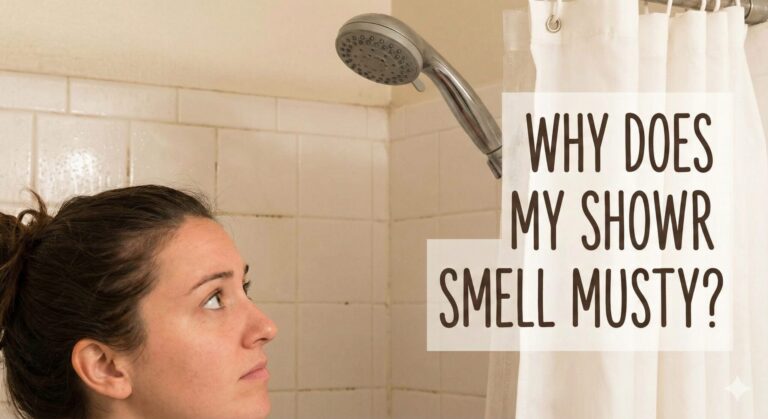Shower Not Getting Hot (But Sink Is)? A Pro’s Guide to Diagnosing and Fixing It
It’s a miserable start to the day: you step into the shower, turn the handle to hot, and are met with a blast of lukewarm or icy-cold water. You wait. And wait. Nothing. Frustrated, you test the bathroom sink faucet and… steaming hot water comes out instantly. What gives?
This is a very common problem, and it’s also a huge clue. If your sink has hot water but your shower doesn’t, it means your water heater is working perfectly. The problem is isolated entirely to the shower itself. And the hero (or villain) of this story is a small, replaceable part inside your shower handle called a **mixing valve cartridge**.
This guide will show you exactly how a professional would diagnose this issue and how you can fix it yourself, likely for under $50 and in about an hour, saving you a costly plumbing bill.
The #1 Culprit: A Failed Shower Valve Cartridge
Behind your shower handle, inside the wall, is a brass fixture called a shower mixing valve. Its job is to blend the hot and cold water from your pipes to deliver the perfect temperature you select. The “brains” of this operation is a removable, and often plastic, cartridge. This cartridge is a hard-working part that fails over time.
Why Your Cartridge Fails and Blocks Hot Water
- Mineral Buildup: This is the most common reason. Hard water deposits and sediment from your pipes build up inside the tiny channels of the cartridge. Often, these deposits will block the hot water inlet port while still allowing cold water to pass through, giving you a cold shower.
- Worn O-Rings & Gaskets: The cartridge is sealed with several rubber O-rings. As these degrade, they can break apart and cause blockages or fail to properly separate the hot and cold chambers, resulting in a shower that’s only lukewarm or “not hot enough.”
- Cracks or Damage: Over years of use, the plastic body of the cartridge can develop hairline cracks, causing it to malfunction.
The solution is simple: replace the old, failed cartridge with a new one. It’s like giving your shower a brand-new engine.
How to Replace Your Shower Valve Cartridge: A Step-by-Step Guide
This might sound intimidating, but it’s a very manageable DIY project. Follow these steps carefully for a successful repair.
-
CRUCIAL FIRST STEP: Turn Off Your Water! Find the main water shutoff valve for your house (often in a basement, garage, or utility closet) and turn it completely off. Then, open a faucet to drain the remaining water from the pipes.
- Identify Your Faucet Brand. You need the EXACT replacement cartridge. Look for a brand name (e.g., Moen, Delta, Kohler, American Standard) on the shower handle or the decorative trim plate behind it.
- Remove the Handle. Most handles are held on by a very small screw. It’s often hidden under a plastic cap on the front or in a small hole on the side (you’ll need an Allen key for this type).
- Remove the Trim/Sleeve. With the handle off, you can usually slide off the decorative metal sleeve and trim plate, exposing the valve in the wall. You might need to unscrew the plate.
- Remove the Retaining Clip. Look closely at the top of the valve. You will see a small, U-shaped metal clip holding the cartridge in place. Use needle-nose pliers or a flathead screwdriver to pull this clip straight up and out. Don’t lose it!
-
Pull Out the Old Cartridge. This can be the trickiest part. The cartridge may be stuck from years of mineral buildup. Wiggle it back and forth with pliers to loosen it. If it won’t budge, you may need a specialty **cartridge puller tool** (see products below). This tool is a lifesaver and prevents you from damaging your plumbing.
Take a photo of the old cartridge before you leave for the store, or better yet, bring the old part with you to ensure you buy a perfect match.
- Install the New Cartridge. Lightly coat the O-rings of the new cartridge with plumber’s silicone grease. This helps it slide in easily and creates a better seal. Make sure to orient it correctly—many have “H” and “C” markings. Push it in firmly until it’s fully seated.
- Reassemble and Test. Re-insert the retaining clip, ensuring it clicks into place. Now, go turn the main water supply back on SLOWLY. Check for any drips around the valve. If it’s dry, re-install the trim plate and handle. You’re done!
Problem: Shower Not Getting Hot *Enough*? Adjust the Anti-Scald Device
If your shower gets warm but not truly hot, the issue might be a safety feature called an **anti-scald device** or **rotational limit stop**. This is a plastic ring, usually with teeth like a gear, that sits right behind your handle. It’s designed to physically stop the handle from turning too far into the hot zone to prevent burns.
Sometimes, these are set too conservatively at the factory. You can easily adjust it to allow for more hot water.
- Remove the shower handle (Step 3 above).
- You will see the plastic, gear-like ring on the valve stem.
- Simply pull this ring off, rotate it a few notches counter-clockwise (towards “hot”), and push it back on.
- Put the handle back on and test the temperature. You’ve now increased the maximum hot water limit.
Essential Tools & Parts for the Job
Having the right tool can turn a frustrating job into a simple one. Here are the key items you might need.
Moen 1222 Posi-Temp Replacement Cartridge
This is one of the most common shower cartridges in U.S. homes. If you have a single-handle Moen shower, this is likely the part you need. Always double-check your old part to be sure, but this is the hero that restores hot water for thousands of people.
Check Price on Amazon
Danco Cartridge Puller Tool for Moen
If your old cartridge is stuck fast, DO NOT try to force it out with pliers. You could break the valve in the wall. This specialty tool is designed to grip the cartridge and use leverage to pull it out safely and easily. It’s worth its weight in gold.
Check Price on Amazon
Waterproof Silicone Grease
A small tube of this grease is a plumber’s best friend. Applying a light coat to the rubber O-rings on your new cartridge helps it slide in smoothly, protects the rubber from damage, and ensures a watertight seal for years to come.
Check Price on Amazon
What if my sink ALSO has no hot water? If there’s no hot water anywhere in the house, the problem is not your shower. It’s your water heater. If you have a gas heater, the pilot light may be out. If electric, a heating element or thermostat may have failed. This usually requires a professional.







